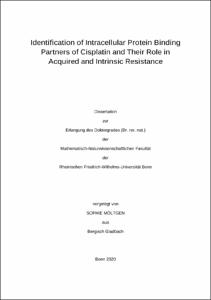Identification of Intracellular Protein Binding Partners of Cisplatin and Their Role in Acquired and Intrinsic Resistance

Identification of Intracellular Protein Binding Partners of Cisplatin and Their Role in Acquired and Intrinsic Resistance

| dc.contributor.advisor | Jaehde, Ulrich | |
| dc.contributor.author | Möltgen, Sophie | |
| dc.date.accessioned | 2021-03-18T08:01:29Z | |
| dc.date.available | 2021-03-18T08:01:29Z | |
| dc.date.issued | 18.03.2021 | |
| dc.identifier.uri | https://hdl.handle.net/20.500.11811/8987 | |
| dc.description.abstract | Cisplatin is a widely used drug in treatment of various solid tumors, amongst others ovarian cancer. However, whereas acquired resistance significantly limits therapy success, some tumors such as colorectal cancer are intrinsically insensitive to cisplatin. Only a small amount of intracellular platinum binds to the target, genomic DNA. The fate of the remaining drug is still largely obscure. The aim of this thesis was to identify cytosolic binding partners of cisplatin in ovarian and colorectal cancer cells and to evaluate their relevance for cell sensitivity to cisplatin.
Three different approaches were examined for their performance to identify cisplatin binding partners. The application of copper-catalyzed azide-alkyne cycloaddition suffered from low specificity and high background binding. Immunoprecipitation was limited in terms of reproducibility and yield. By contrast, using the fluorescent cisplatin analog BODIPY-cisplatin, two-dimensional gel electrophoresis and MS, binding partners in the A2780 and cisplatin-resistant A2780cis ovarian carcinoma as well as in HCT-8 and oxaliplatin-resistant HCT-8ox ileocecal colorectal adenocarcinoma cell lines could successfully be identified. Furthermore, the relevance of four of these proteins (vimentin, GSTP1, DJ-1 and Grb2) for the sensitivity of the cells to platinum drugs was assessed by means of pharmacological inhibition and siRNA-mediated knockdown. Interestingly, silencing of GSTP1 significantly sensitized intrinsically resistant HCT-8 and HCT-8ox cells to cisplatin. This finding implies the possible involvement of GSTP1 in the intrinsic resistance of colorectal cancer cells to cisplatin and may offer a great opportunity to further elucidate the distinct mechanisms of action of cisplatin vs. oxaliplatin in this tumor entity. It was also demonstrated that the inhibition of vimentin by the recently developed inhibitor FiVe1 led to a significant sensitization of ovarian cancer cells to cisplatin and to a reversal of resistance in the cisplatin-resistant cell line. These results warrant a further evaluation of vimentin as a target of antitumor therapy and FiVe1 as a possible combination partner of cisplatin. | en |
| dc.language.iso | eng | |
| dc.rights | In Copyright | |
| dc.rights.uri | http://rightsstatements.org/vocab/InC/1.0/ | |
| dc.subject.ddc | 500 Naturwissenschaften | |
| dc.title | Identification of Intracellular Protein Binding Partners of Cisplatin and Their Role in Acquired and Intrinsic Resistance | |
| dc.type | Dissertation oder Habilitation | |
| dc.publisher.name | Universitäts- und Landesbibliothek Bonn | |
| dc.publisher.location | Bonn | |
| dc.rights.accessRights | openAccess | |
| dc.identifier.urn | https://nbn-resolving.org/urn:nbn:de:hbz:5-61608 | |
| ulbbn.pubtype | Erstveröffentlichung | |
| ulbbnediss.affiliation.name | Rheinische Friedrich-Wilhelms-Universität Bonn | |
| ulbbnediss.affiliation.location | Bonn | |
| ulbbnediss.thesis.level | Dissertation | |
| ulbbnediss.dissID | 6160 | |
| ulbbnediss.date.accepted | 18.02.2021 | |
| ulbbnediss.institute | Mathematisch-Naturwissenschaftliche Fakultät : Fachgruppe Pharmazie / Pharmazeutisches Institut | |
| ulbbnediss.fakultaet | Mathematisch-Naturwissenschaftliche Fakultät | |
| dc.contributor.coReferee | Staal, Ganna Vasylivna |
Dateien zu dieser Ressource
Das Dokument erscheint in:
-
E-Dissertationen (4466)




